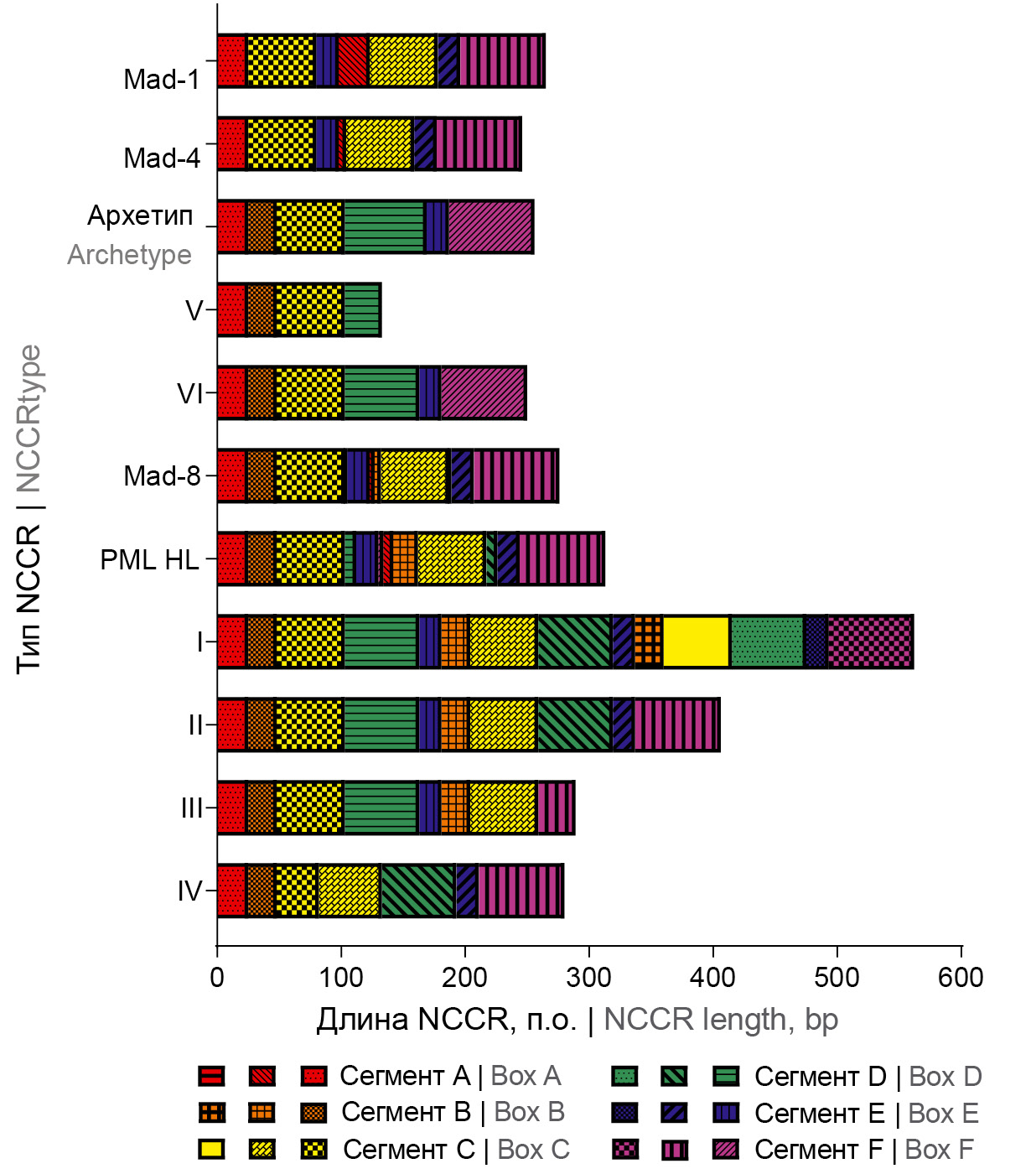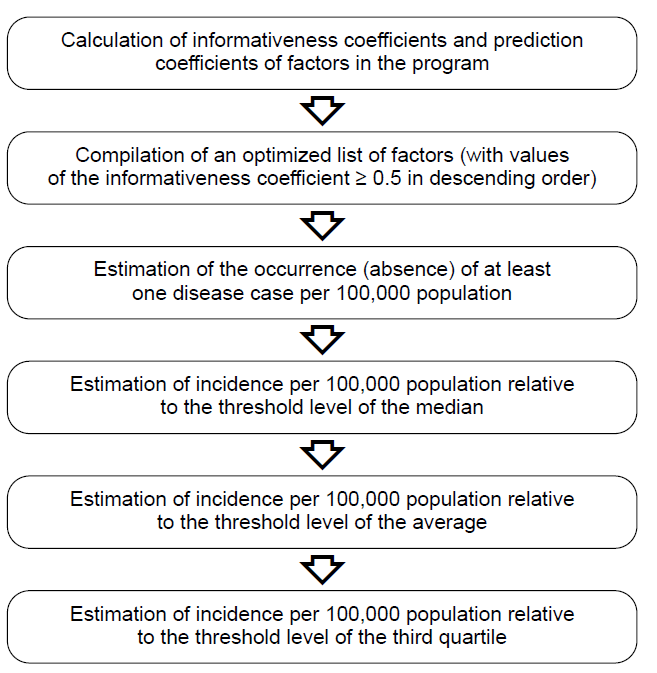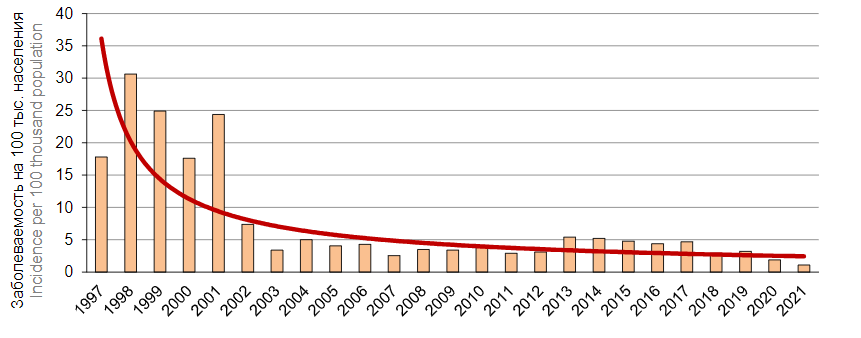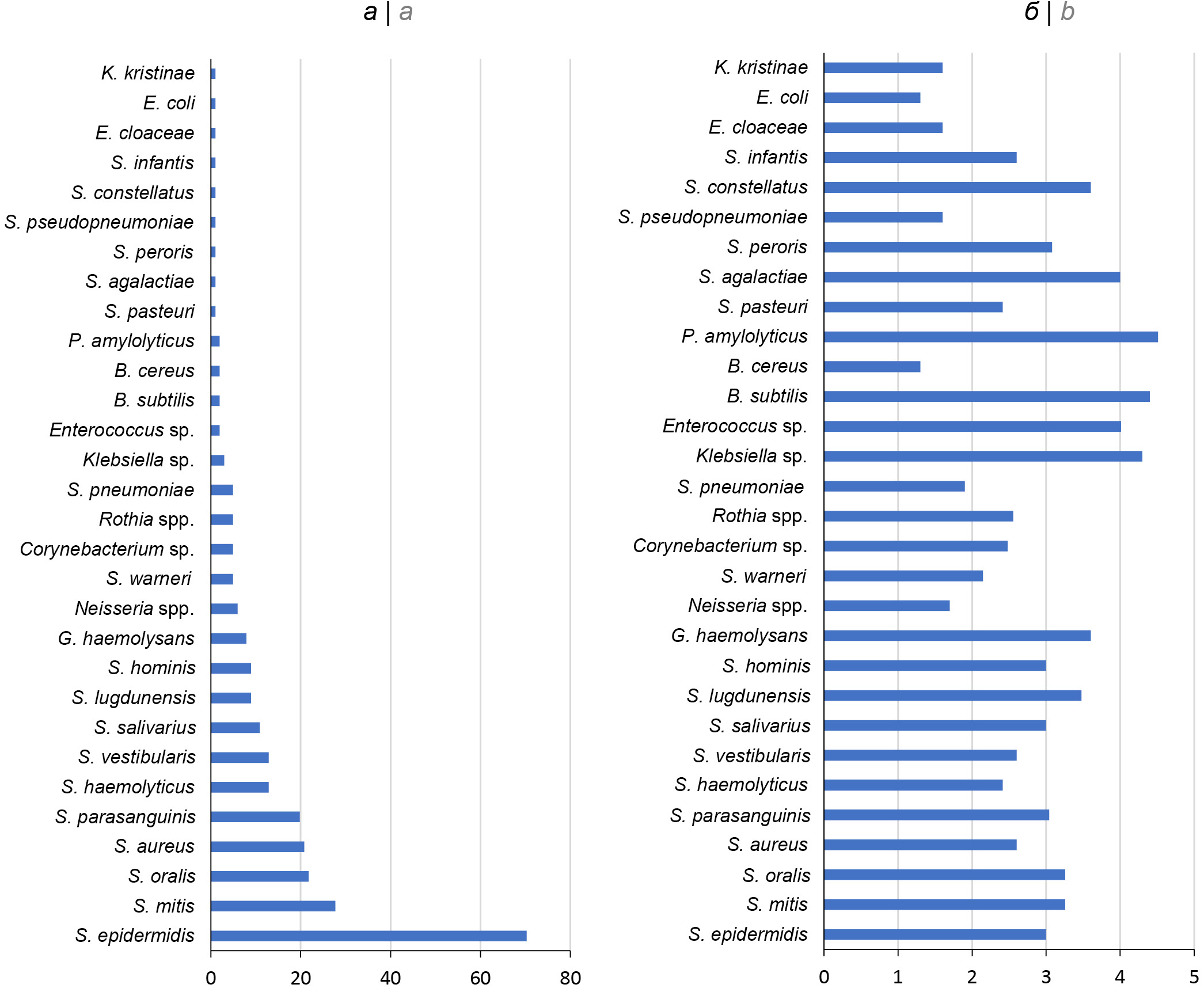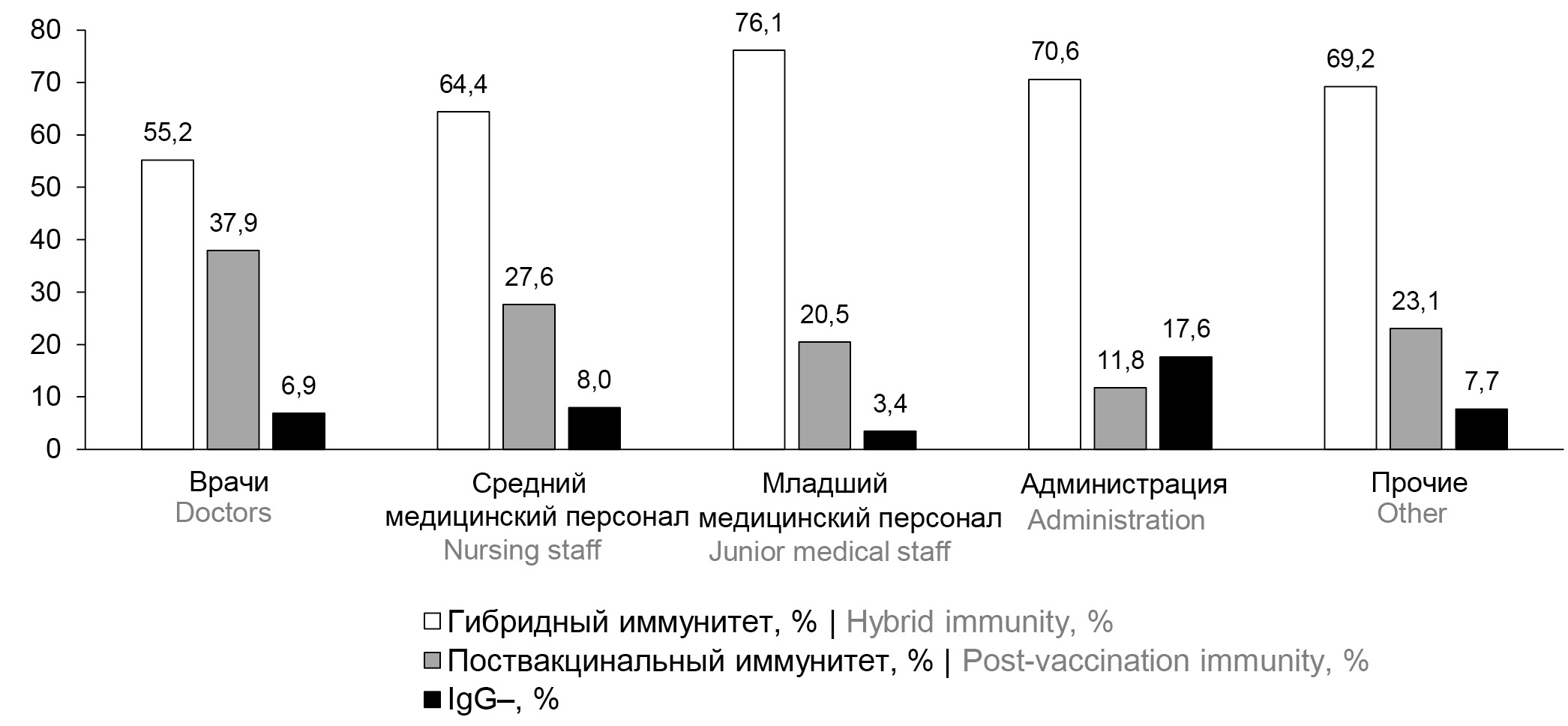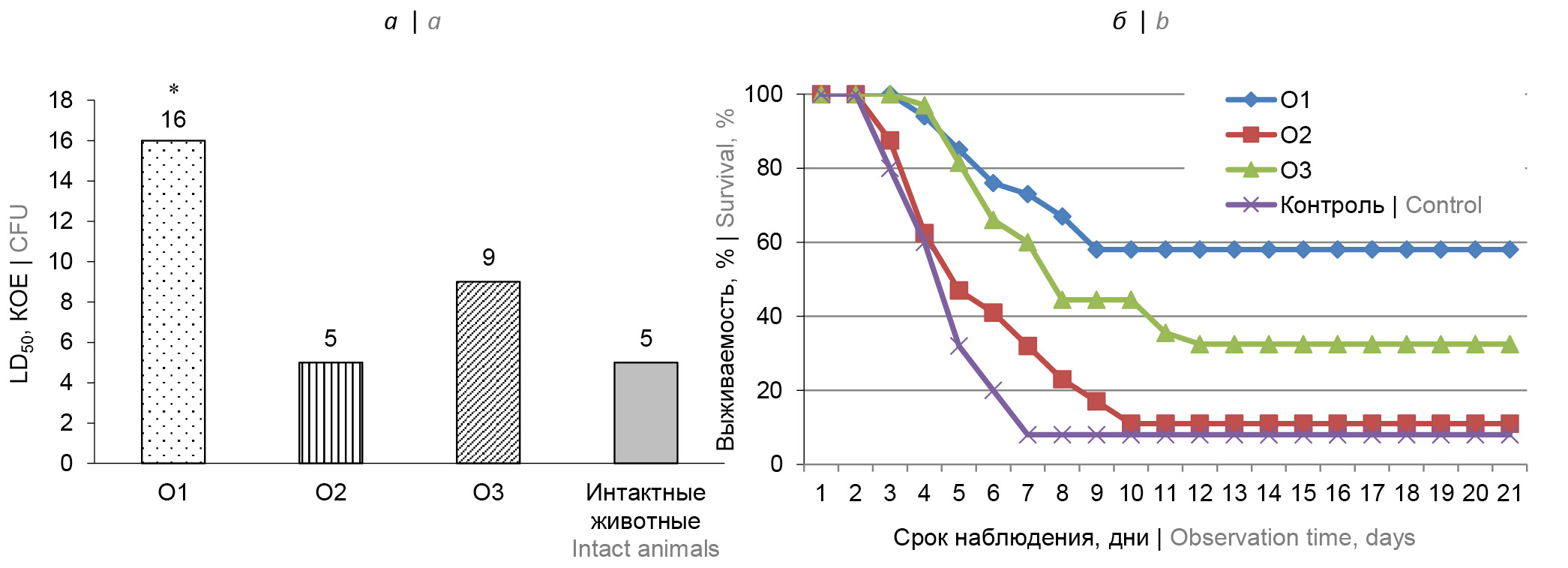Vol 100, No 1 (2023)
- Year: 2023
- Published: 03.04.2023
- Articles: 12
- URL: https://microbiol.crie.ru/jour/issue/view/54
ORIGINAL RESEARCHES
Sequence analysis of the non-coding control region of John Cunningham virus isolates from patients with multiple sclerosis treated with natalizumab
Abstract
Introduction. The John Cunningham virus (JCPyV) causes a fatal demyelinating disease of the central nervous system known as progressive multifocal leukoencephalopathy (PML). In healthy people, the JCPyV non-coding control region (NCCR) is not rearranged, while NCCRs in immunocompromised patients are characterized by frequent rearrangements and can be associated with PML development. Therefore, patients treated with natalizumab, which decreases the migration of leukocytes and monocytes through the blood-brain barrier to inflammatory foci, are at increased risk of developing PML.
The purpose of the study was to analyze NCCR sequences of JCPyV isolates from patients with multiple sclerosis (MS) treated with natalizumab.
Materials and methods. A total of 26 blood plasma samples and 8 cerebrospinal fluid samples were analyzed using nested PCR to study the JCPyV NCCR structure in Russian MS patients treated with natalizumab. The NCCRs present in the samples were cloned and sequenced by Sanger sequencing. All the JCPyV NCCR sequences were compared with the archetype sequence and mapped. The NCCR sequences were also examined for presence of putative transcription factor binding sites.
Results. A total of 48 NCCR sequences were found. The analysis showed that up to 55% of NCCRs were identified as rearranged NCCRs, while the other were archetype-like NCCRs. All the sequences can be divided into 6 types with one dominant rearrangement pattern. This rearranged NCCR was also found in a patient with the confirmed PML diagnosis and a poor prognosis. All the rearranged NCCRs were characterized by the presence of additional transcription factor binding sites.
Conclusion. The study has helped identify previously unknown NCCR patterns typical of MS patients treated with natalizumab in Russia, thus confirming the need for the further research on NCCR rearrangements in MS patients undergoing natalizumab treatment to gain better understanding of the origin of neurovirulent JCPyV variants.
 7-25
7-25


The association between Candida albicans sensitivity to antimycotic drugs and the architecture of their microbial community in the oropharynx of HIV infected patients
Abstract
Relevance. Candida infection remains relevant due to the wide spread of antimycotic-resistant strains of Candida fungi, especially among immunocompromised individuals. It was previously discovered that the Candida spp. microbial community in the biotope of the oropharynx of HIV infected patients is characterized by a certain architecture: they can be present in this biotope in the form of a monoculture or as association of co-isolates. It has been suggested that the architecture of the Candida microbial community may influence their resistance to antimycotic drugs.
Purpose — a comparative study of the association between the architecture of the C. albicans microbial community in the oropharynx of HIV infected patients with oropharyngeal candidiasis and their sensitivity to antimycotic drugs.
Materials and methods. A microbiological study of 52 isolates of Candida fungi (C. albicans, C. glabrata, C. tropicalis and C. krusei) from the oropharynx of 31 HIV infected patients with clinical manifestations of oropharyngeal candidiasis aged 20 to 69 years with almost equal gender distribution was carried out. In the form of monocultures, 18 isolates were isolated, while 34 were identified as co-isolates, which formed 16 homogeneous communities that included strains of the same species, and 18 heterogeneous ones that consisted of fungi of various species.
Results. It was found that heterogeneous communities of C. albicans were markedly distinguished by sensitivity to antimycotic drugs, in particular, by low sensitivity to imidazoles. Homogeneous communities practically did not differ from monocultural ones. The general properties of the C. non-albicans population were largely similar to those of C. albicans, but were characterized by lower heterogeneity in response to antimycotic drugs.
Conclusion. The architecture of the community of C. albicans isolated from the oropharynx of HIV infected patients with clinical manifestations of oropharyngeal candidiasis affects their sensitivity to antimycotic drugs. When selecting effective antimycotic therapy for such patients, it is necessary to take into account the structure of the Candida spp. community in the oropharynx.
 26-33
26-33


Explanatory models for tick-borne disease incidence (Astrakhan rickettsial fever and Crimean-Congo hemorrhagic fever)
Abstract
Introduction. The study focuses on methods providing mathematical substantiation of discrepancies between actual incidence rates of Astrakhan rickettsial fever (ARF) and Crimean-Congo hemorrhagic fever (CCHF) and predicted rates due to the indirect impact of weather conditions during the current epidemic season.
The purpose of the study was to develop explanatory models for ARF and CCHF incidence using satellite monitoring (remote sensing) data and to present the results of their practical evaluation in the Stavropol Territory and Astrakhan Region.
Materials and methods. The materials included climate data provided by the Space Research Institute of the Russian Academy of Sciences as well as epidemiological data on CCHF and ARF incidence from 2005 to 2021. The explanatory models incorporated the Bayes theorem and Wald sequential analysis. All the calculations were completed using the Microsoft Excel 2010-based program developed by the authors.
Results. It has been found that the greatest indirect effect on development of the CCHF epidemiological situation is produced by the normalized difference vegetation index and relative air humidity in June-July in the Stavropol Territory and by the maximum, minimum and average air temperature in October as well as the minimum air temperature in July in the Astrakhan Region. ARF incidence rates depend on the indirect effect of the annual average and average annual maximum temperature, maximum temperature and the normalized difference vegetation index in April-July. The match between explanatory model-based results and prediction model-based results ranged within 46.2-100%.
Discussion. In addition to projecting incidence rates, which could be reached with the observed values of climatic factors in the current year, the explanatory models can be used for indirect verification of prediction models and for identification of factors causing differences in results.
Conclusion. The practical evaluation of explanatory models confirms the prospects and benefits of the study that should be continued, involving other regions highly endemic for tick-borne infections.
 34-45
34-45


Assessment of herd immunity to hepatitis A virus among the population of the Republic of Tatarstan
Abstract
Introduction. Identification of the groups of the population most susceptible to infection with hepatitis A virus (HAV) is a key component for the regulation of anti-epidemic measures during the activation of the epidemic process.
The aim — аssessment of the herd immunity to hepatitis A (HA) among different age groups of the population of the Republic of Tatarstan.
Materials and methods. The analysis of the HA incidence of from 2006 to 2021 and the study of herd immunity to HA among 6,553 persons from different age groups that were not vaccinated against HA were carried out. Participants with protective concentrations of antibodies to HAV of 20 mMU/ml or more were considered as seropositive.
Results. The analysis showed a low intensity of the epidemic process in general (3.6 ± 0.3о/оооо), while the HA incidence among children and adults was significantly different, with incidence rates 2.3 times higher in the first group (6.9 ± 0.9 and 3.0 ± 0.3о/оооо, respectively). The epidemic process is determined by persons aged 15–17 years (8.2 ± 2.5о/оооо), 3–6 years (7.0 ± 1.9о/оооо, 7–14 years (6.2 ± 1.3о/оооо), the incidence among these age groups in all observed years remained the highest. In general, the proportion of seropositive children was 32.1 ± 1.0%. Among adults, anti-HAV IgG antibodies in a protective concentration was detected in 68.2 ± 0.7%. The highest frequency of anti-HAV IgG positive samples was observed among persons aged 50–59 years — 89.4 ± 1.1%, in age group 40–49 years — 73.5 ± 1.2%, in age group 30–39 years — 65.5 ± 1.3%, and in age group 20–29 years — 48.2 ± 1.6%. In total, 56.9 ± 0.6% of the examined individuals had protective antibodies to HAV. The detection rates of anti-HAV IgG antibodies were significantly different in all age groups (p < 0.05).
 46-51
46-51


Clinical and epidemiological characteristics of cancers associated with human papillomavirus in the regions of North-West Russia
Abstract
Introduction. The leading role of the human papillomavirus in the etiopathogenesis of malignant neoplasms of some localizations is generally recognized. Vaccines that are used in the world and in Russia for the prevention of papillomavirus infection create the basis for the elimination of diseases associated with the human papillomavirus in the future.
The aim of the study is to determine the regional, gender and age-specific features of cancers associated with the human papillomavirus to substantiate the development of a unified system of epidemiological surveillance and vaccination.
Materials and methods. The retrospective epidemiological analysis of the incidence of cancers associated with the human papillomavirus and mortality due to these neoplasms in the regions of the North-Western Federal District of Russia in 2011–2020 was carried out based on data from Statistic Form 7 "Information on malignant neoplasms" and the Population cancer Registers of St. Petersburg (13,117 cases), Leningrad region (3204 cases) and the Kaliningrad region (2898 cases).
Results. In the structure of cancers associated with the human papillomavirus in St. Petersburg, Leningrad and Kaliningrad regions, more than 90% of men had tumors of the oral cavity, oropharynx and larynx, more than 60% of women had cervical cancer. Regional and age-specific features of the incidence of cervical cancer and mortality from this pathology have been established. Statistically significant differences in the incidence of cancer of the head and neck, anus and anal canal in different age groups of the male and female population were revealed.
Conclusion. As a result of the study, regional, gender and age-specific features of the incidence of human papillomavirus-associated malignant neoplasms in the North-West of Russia were established. These data should be used to develop a system of epidemiological surveillance of papillomavirus infection and vaccination program.
 52-64
52-64


Standard definition of a clinical case of mumps and diagnostic effectiveness of the test systems used in the modern period
Abstract
Introduction. Registration of regular epidemic outbreaks of mumps infection among young people, difficulties in the clinical diagnosis of the disease, the presence of specific clinical manifestations in adults with a severe course of infection make it necessary the improvement of the quality of diagnosis of the disease.
The aim of the work is to develop a standard definition of a clinical case of mumps and to conduct a comparative assessment of the effectiveness of the diagnostic test systems used for mumps diagnostics based on the determination of their sensitivity and specificity.
Materials and methods. To develop a standard definition of a clinical case of mumps based on ten combined clinical and laboratory parameters, a mathematical model was built using the logistic regression method. The study included 84 patients with mumps infection (main group) and 66 patients with non-epidemic sialoadenitis (comparison group). For a comparative evaluation of the diagnostic systems VectoParotitis-IgM, VectoParotitis-IgG, ELISA-Mumps-IgM, ELISA-Mumps-IgG, Anti-Mumps Virus ELISA-IgM, and Anti-Mumps Virus ELISA-IgG, a blood serum samples from patients (n = 41) with a diagnosis “mumps?” were tested in dynamics to assess their sensitivity, specificity, and diagnostic effectiveness.
Results. The clinical symptom “dry mouth” increased the chance of diagnosing mumps by 13.7 times, the presence of bilateral lesions of the salivary glands — by 6.5 times, the increase in the level of diastase in the urine — by 3.2 times. The coefficient of determination R2 was 61.1; the sensitivity was 93% and the specificity — 67%; p < 0.001. Diagnostic effectiveness of “Anti-Mumps Virus ELISA-IgG” test system was 84.4%, ELISA-Mumps-IgG — 87.2%, and "VectoParotitis-IgG" — 88.5%.
Conclusions. Based on the combination of following clinical symptoms observed simultaneously in patient, of the general weakness, dry mouth, bilateral lesions of the salivary glands, an increase in the level of diastase in the urine, it is possible to establish a clinical diagnosis of mumps with a probability of 81%. The highest diagnostic effectiveness of domestically manufactured test systems for quantitation of IgG antibodies to mumps virus in sick people has been demonstrted.
 65-73
65-73


Opportunistic microbiota of breast milk and antimicrobial activity of milk whey at different periods of lactation
Abstract
Object of study. The evaluation of the interaction between breast milk opportunistic microorganisms abundance and the milk whey antimicrobial activity at different periods of lactation.
Materials and methods. 100 samples of breast milk from healthy breastfeeding mothers were inoculated on solid selective media, and then pure cultures of microorganisms were identified by MALDI-TOF mass spectrometry. The antimicrobial activity of the whey against a model culture of Candida albicans was evaluated by spectrophotometry.
Results. 270 isolates represented by 36 species of 13 genera of opportunistic bacteria were obtained. None of the 100 samples contained opportunistic fungi. Staphylococci (7 species) and streptococci (11 species) were predominant. The most common were staphylococci — S. epidermidis (70.2%) and S. aureus (20.8%), and streptococci — S. mitis (27.7%) and S. oralis (21.8%). The total contamination (median) of opportunistic bacteria in the colostrum was 7–9 × 103 CFU/ml, transitional milk — 4 × 103 CFU/ml, mature milk — 5 × 102 CFU/ml. The antimicrobial activity of colostrum whey was 87.4–89.4%; transitional milk — 88.2%; mature milk — 63.4–81.9%. The total contamination had a high inverse correlation with the lactation period (r = –0.806) and a high positive correlation with the antimicrobial activity of whey (r = 0.699). Meanwhile, a significant decrease in contamination was noted after 1 month from the beginning of lactation, while a significant decrease in antimicrobial activity was observed after 8 months.
Conclusions. The decrease of the breast milk contamination by opportunistic bacteria during the lactation period was found to be primary compared to the decrease of the whey antimicrobial activity. Thus, changes in the whey antimicrobial protection factors occur in response to changes of the opportunistic microbiota abundance.
 74-83
74-83


Assessment of humoral immunity to SARS-CoV-2 by a sample examination of medical workers in a large specialized multidisciplinary hospital
Abstract
Introduction. The assessment of specific IgG antibodies to RBD Spike SARS-CoV-2 and their quantitation permit to calculate the intensity of immunity to COVID-19, i.e. to determine the level of immunity to infection, the risk of infection, the severity of the disease, as well as the ability to prevent death. Meanwhile, the protective level of antibodies is not determined. Therefore, determining the nature of immunity and quantitation of IgG antibodies to RBD Spike SARS-CoV-2 make it possible to assess the effectiveness of preventive measures and correct them in a timely manner.
The aim is to determine the presence of IgG antibodies to RBD Spike SARS-CoV-2, their concentrations, and the nature of humoral immunity in different age and occupational groups of employees in a closed-type hospital after the completed vaccination with "Gam-Covid-Vac" vaccine.
Materials and methods. The blood sera of 310 members of medical staff who received a full course of immunization with the "Gam-Covid-Vac" vaccine were tested using "SARS-CoV-2-ELISA-IgG" kit according to instructions provided in 21.20.23-004-28597318-2020, RU No. RZN 2021/15898. IgG antibodies to RBD Spike SARS-CoV-2 were quantitated against WHO standard NIBSC 20/136.
Results. Specific IgG antibodies to RBD Spike SARS-CoV-2 were found in 92.9% of the examined individuals, including 67.4% having hybrid immunity (both vaccine- and infection- induced), and 25.5% having post-vaccination immunity after immunization with the "Gam-Covid-Vac" vaccine; 7.1% participants were nonimmune. A higher level of IgG antibodies to RBD Spike SARS-CoV-2 was detected in the group of individuals with hybrid immunity (p < 0.01). Only 11.6% of employees had a protective antibody level of more than 300 BAU/ml.
Discussion. Most employees with hybrid immunity were identified in the older age groups and in the junior medical staff. The results of this serological study, taking into account the age and professional aspects, can serve as the basis for adjusting preventive measures in medical institutions.
 95-102
95-102


Increasing the immunogenic and protective activity of the vaccine strain Yersinia pestis EV line NIIEG using synthetic immunomodulators
Abstract
Introduction. One of the main tasks of specific plague prevention remains the development of vaccines and their application schemes aimed at improving the effectiveness of vaccination through the use of adjuvants and immunomodulators.
The purpose of the study were comparative evaluation of the effect of drugs from the group of synthetic immunomodulators on the immunogenic and protective properties of the Yersinia pestis EV line NIIEG vaccine strain in model animal experiments.
Materials and methods. White mice and guinea pigs were immunized with the vaccine strain Y. pestis EV line NIIEG. The animals of the experimental groups were injected with oligopeptides O1 (Threonyl-glutamyl-lysyl-lysyl-arginyl-arginyl-glutamyl-threonyl-valyl-glutamyl-arginyl-glutamyl-lysyl-glutamate), O2 (Glutamyl-cysteinyl-glycine disodium) and O3 (Arginyl-alpha-aspartyl-lysyl-valyl-tyrosyl-arginine) one hour before vaccination or three times before infection. On days 3, 14 and 21, antibody and cytokine products were studied. Animals were infected with the test strain Y. pestis 231(708) at a dose of 400 LD50.
Results. It was found that a single administration of immunomodulators 1 hour before vaccination did not change the susceptibility of animals to the plague microbe: ImD50 = 5860 (O1); 5860 (O2); 6454 (O3) and 6876 (control) CFU for white mice and 446 (O1), 551 (O2), 446 (O3) and 578 (control) CFU for guinea pigs. Three-time administration of drugs to vaccinated animals led to a decrease in the ImD50 Y. pestis EV line NIIEG indicators in the group with O1 by 2.2 times (mice) and 1.8 times (guinea pigs), with O2 and O3 by 1.2 times, regardless of the biomodel compared with the control. The stimulating effect of O1 and O3 on the production of antibodies to F1 of the plague microbe and cytokines interferon-gamma, interleukin-10 has been established.
Conclusion. The stimulating potential of synthetic immunomodulators on the immune system of biomodels immunized by Y. pestis EV line NIIEG has been demonstrated, which determines the prospects of research to improve the schemes of prophylactic vaccination against plague.
 84-94
84-94


Research on the antiviral activity of water-soluble melanin from the pharmaceutical chaga mushroom (Inonotus obliquus) against influenza А virus subtypes H5N1, H3N2 and H1N1pdm09 in experiments in vitro
Abstract
Introduction. Influenza A virus is the cause of epidemics and pandemics that severely affect the health and socioeconomic status of the world's population. The need to develop new methods of etiotropic therapy, and the increasing ability of viruses to counteract the antiviral drugs makes extremely relevant the search for new pharmacologically active substances and the subsequent study of their medicinal properties.
The aim of the study is to conduct research into the antiviral properties of melanin obtained from the pharmaceutical chaga mushroom in relation to different subtypes of the influenza A virus.
Materials and methods. A sample of water-soluble melanin from Inonotus obliquus obtained by alkaline hydrolysis and dried at 40°C was tested for toxicity and antiviral activity. The commercial anti-influenza drug Tamiflu® was used as a reference drug. Statistical processing of the obtained data was carried out according to the Spearman-Kerber method.
Results. Inonotus obliquus melanin (sample 20-24) toxicity markers, such as a maximum tolerable concentration (MTC) of 237.0 µg/mL, and a 50% cytotoxic concentration (CC50) of 153,45 µg/mL were established for MDCK cell culture. The assessment of antiviral activity of test sample against three subtypes of the influenza A virus (H5N1, H3N2 and H1N1pdm09) demonstrated a decrease in the infectivity of the influenza virus by 2.5–3.5 lg with 50% virus-inhibiting concentrations (IC50) of 1.55–9.52 µg/mL. Based on the obtained values of CC50 and IC50, the selectivity indices (SI) of the sample were calculated, characterizing its prospects for further research.
Conclusions. Melanin obtained from the pharmaceutical chaga mushroom showed the highest activity against the strain of the human pandemic influenza virus A/California/04/2009 (H1N1)pdm09, caused a decrease in its infectivity by 3.5 lg and had an IC50 of 1.6 µg/ml. The obtained results indicate the prospects for creating an antiviral drug based on Inonotus obliquus melanins against the influenza virus.
 103-109
103-109


REVIEWS
Gut microbiota and carcinogenesis in various human organs
Abstract
Scientific research in recent years has revealed a significant role of the human microbiome in carcinogenesis. These data served as a rationale for the inclusion of polymorphic microbiomes in the key characteristics of carcinogenesis as an important mechanistic determinant of cancer, in addition to other fundamental biological processes manifested during multi-stage carcinogenesis. The microbiome of the gastrointestinal tract is most actively involved in the pathogenesis of malignant neoplasms of the digestive system due to changes in the quantitative and qualitative composition of the microbiota, and increase in the production of genotoxic bacterial metabolites as factors of carcinogenesis. This review also addresses the changes in the microbiome in lung cancer, associated mainly with the production of short-chain fatty aicids, and in breast and endometrial cancers with specific changes in the composition of the bacterial community towar)ds species involved in the metabolism of estrogen precursors. The probable mechanisms of microorganisms’ participation in the development of prostate cancer (the effect of lipopolysaccharides, antibiotics and deconjugated estrogen) are considered.
Data on the relationship between the composition and metabolic characteristics of the microbiome in various cancer sites open up perspectives for its use in the diagnosis, treatment and prevention of malignant neoplasms and justify the need for further research in this area.
 110-125
110-125


Endolysins of bacteriophages
Abstract
Bacteriophage endolysins are a biologically active substances that play a specific role in the release of phage progeny by degrading the peptidoglycan of the host bacterium. In the light of antibiotic resistance, endolysins are considered as alternative therapeutic agents because of their exceptional ability to target bacterial cells.
Aim — summarization of the data on the biology, structure, mechanisms of action of bacteriophage endolysins, as well as on preparations based on them, which are at different stages of research.
The results of studies of bacterial endolysins over the past 20 years were searched using the Internet resources PubMed, Web of Science, Scopus in English for the keywords: lysin, bacteriophages, holin, antibiotic resistance.
The analysis of literature data showed that the structure of phage endolysins of Gram-positive and Gram-negative bacteria differs from each other and reflects differences in their architecture due to variation in the cell wall composition of these two major bacterial groups. Depending on the cleavable bond in peptidoglycan, endolysins can be divided into at least five different groups: glycosidases (two groups — aminidases and muramidases), endopeptidases, specific amidogyrolases, and lytic transglycosylases. To date, endolysins effective against a number of pathogens have been studied, including Streptococcus pneumoniae, Streptococcus pyogenes, Streptococcus agalactiae, Staphylococcus aureus, Mycobacterium spp., Pseudomonas aeruginosa, etc. A number of studies have shown the therapeutic potential of endolysins in combating antibiotic-resistant infections.
 126-134
126-134










